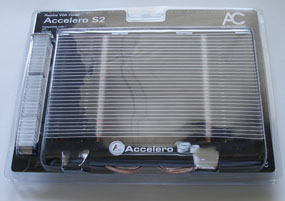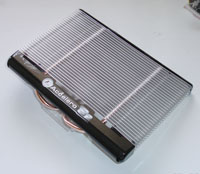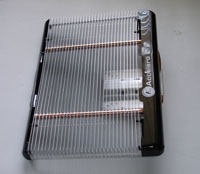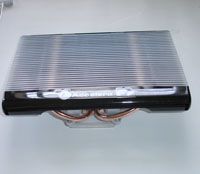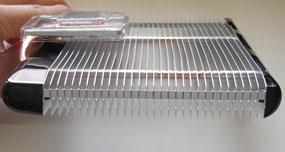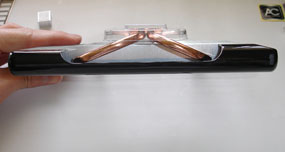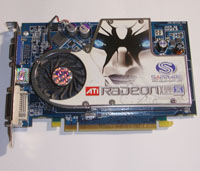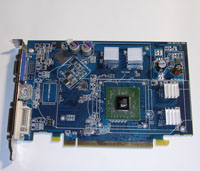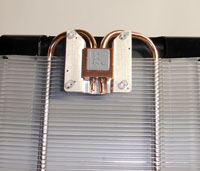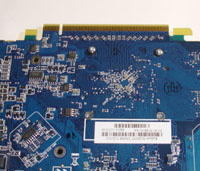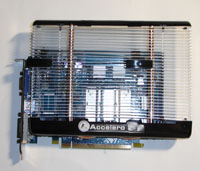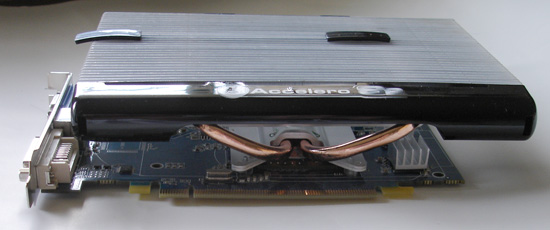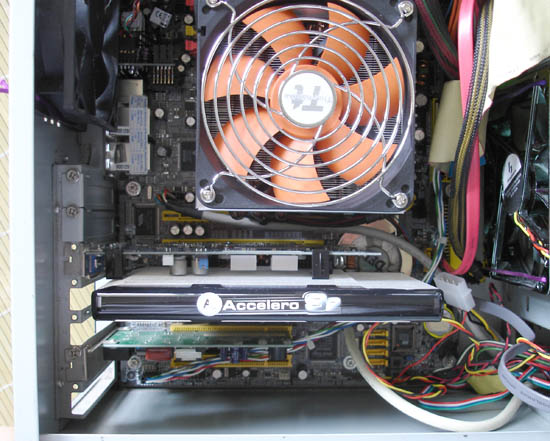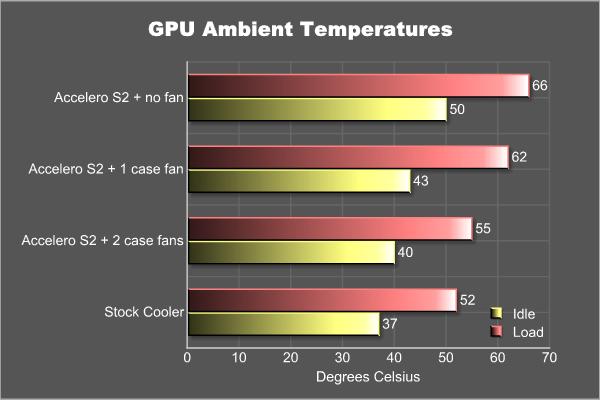Is the noise of graphic card’s fan bugging you? If so, you should check out our review on the Arctic Cooling Accelero S2. The Accelero S2 is a fanless graphic cooler that uses two copper heat pipes and 32 fins to dissipate heat away from the core of the graphic card. Not only it promises to reduce the temperature of your GPU, it will also reduce the system noise. Does it performs as it advertises? Well, read the review and find it out.
INTRODUCTION
In the past, many manufactures would release graphic cards with modified heat sink and fans from reference designs to provide better cooling and to enhance overclocking. However, lately, many manufactures simply sell reference design cards from either AMD/ATI or NVIDIA without any modification except putting their own labels on the card. Therefore, for users who seek to have quieter graphic cards or cooler cards would have to resort to the heat sinks and fans from third party manufactures. Luckily there are no shortages of manufactures that produce well-designed products. Today, we will take a look at one of these products from Arctic Cooling, the Accelero S2, a merely $22 graphic card cooler that promises to reduce operating temperature and overall system noise.
COMPANY PROFILE
Arctic Cooling was founded in 2001 but they quickly has become a well-known manufacture within the industry because of their excellent products in graphic cards cooling that offers excellent performance yet keeping the overall system noise down. According to their site:
ARCTIC COOLING is a private owned company founded in 2001 with headquarters in Switzerland, offices in Hong Kong and with production facilities in Asia. The team of ARCTIC COOLING insists on international young highly educated people with business, technical and communicational skills. The attitude to work is based on the Swiss innovative spirit and adheres to the high Swiss standard recognized internationally. This striving for excellence is integrated in all processes and is a matter of course. ARCTIC COOLING’s core competencies are multifarious such as systematic noise reduction, copper and aluminum heatsinks, customizing of thermal solutions, “Just-in-time” fan manufacturing, Ceramic Bearing, Multiple Signal Output / BIOS interface and low noise fan blade design.
TECHNOLOGY
FEATURES AND DESIGN
Features and Specification
- Heat Sink: 140(L) x 188(W) x 32(H) mm
- Heat pipe: 6 mm x 2
- Weight: 202 g
- Accessories: 8 Memory Heat Sinks
- Noiseless Cooling
- Dual Heat Pipes
- Memory Cooling
- High Reliability
- Low Weight
- 6 Years Warranty
- Compatible Cards
- ATI:
X1650, X1600, X1550, X1300, X1050 series
X850, X800, X700, X600, X550, X300 series
9XXX series - nVIDIA:
GeForce 7600, 7300, 6600 series
FX 5950, 5900, 5700 (Ultra) series
FX 5600, 5500, 5200 series
GeForce 4 Ti, MX series
- ATI:

Here are the accessories for mounting the Accelero S2 to the graphic card.
INSTALLATION
Installing the unit is a fairly easy task. First, I remove the Sapphire stock cooling and clean the core. Then, follow the instruction manual, I remove the double sided tape from the back of the memory heat sink and place it onto the graphic card’s memory. Afterward, I then remove the double sided tape on the back of the heat sink and position the plastic stand-off to the base of the cooler. The stand-off is designed to protect the core of the GPU from being damaged. I then align the mounting hole of the heat sink to the graphic card and screw two screws on the back of the heat sink. The next step is what I found to be slightly bothersome. You would have to use the included T-shaped and L-shaped clips to secure the heat sink. I found that aligning them is slightly difficult given to the sheer size of the heat sink. Luckily there’s enough space between the heat sink and the graphic card for my finger to go in to hold the clip. After the clips are secured onto the unit, the screws are then fastened tight in alternating manner. The overall installation is fairly simple.
We can see from the images above, the Accelero S2 is massive compared to the X1600XT graphic card. The cooler has enough clearance from any components on the graphic card.
Before installing the card back to our test system, be sure to mount the bracket to the case. Here we can see the X1600XT with Accelero S2 installed on DFI NF4 SLI-DR motherboard inside the Antec Sonata case.
TESTING
|
System Configuration |
|
|
Processor |
AMD Athlon 64 X2 4200+ Manchester |
| CPU Heatsink | Thermaltake Big Typhoon with Arctic Silver 5 |
|
Motherboard |
DFI LanParty NF4 SLI-DR (BIOS NF4LD406) |
|
Memory |
2x G.Skill Extreme Series (F1-3200PHU2-2GBZX) |
|
Hard Drive |
Maxtor DiamondMax Plus10 250GB Hard Drive (Maxtor 6B250S0), 250GB, 7,200 rpm, 16 MB Cache, SATA 150 |
|
Graphics Cards |
Sapphire X1600XT, Catalyst Driver 7.5 |
|
Sound Card |
Onboard |
|
Power Supply |
Zalman ZM460-APS |
| Case | Antec Sonata |
|
Operating System |
Windows XP SP2 |
| Chipset Driver |
ForceWare 6.86 |
Testing Condition
I decided to test this heat sink with my Sapphire X1600XT and put the card in the Antec Sonata. The Sonata case is known to be fairly quiet and has good amount of air flow. I decided to test the heat sink in various configurations:
- Two case fans: one intake in the front and one exhaust in the rear
- Antec 120mm case fan from Sonata
- Bluegears b-flexi120: 120mm, 48.75 CFM, 1500 RPM
- One case fan positioned at the rear
- Antec Sonata case fan
- No case fan
The purpose of these tests is to determine the minimum amount of fans needed to maintain a good cooling condition while keep the noise down. Since people who would purchase a fanless heat sink would most likely want a system where the noise level is kept to absolutely minimal, these tests would help them decide whether it would be a good idea to replace their cooler with Accelero S2.
The graphic card is tested with ATI Tool 0.26’s “Scan for Artifacts” for a period of 30 minutes. The temperature is recorded with Everest 4.0 during the test at interval of 30 seconds.
RESULT
Before we take a look at the result, I do want to emphasize that the result of the benchmark will be highly dependable on system air flow since the Accelero S2 is fanless cooler and it relies heavily on system’s overall cooling ability. Also, the position of the fans could make a huge difference as well. Okay, let’s take a look at the numbers.
The result can be described in one word, amazing! I had expected the Accelero S2 to help to cool the card but I didn’t expect to see such a great result. The Accelero S2 is able to keep the GPU temperature 20°C or less, depends on how well the system is ventilated, compare to the stock cooling . The resutl suggests that a proper ventilation inside the case is absolutely critical in order to keep the card running cool with the Accelero S2. Having just an exhaust fan in the rear of the case will not produce enough air flow to provide a great result. Simply adding a front intake fan has greatly reduced the temperature from 58°C to 48°C, a whopping 10°C difference.
Despite the fact that we see the Accelero S2 is able to keep the card running at “cool” at 63°C without any additional case fans, I would strongly advice against using the heat sink alone without any case fans since I observed the temperature continuing to climb up as the benchmark proceeded. I am not sure if the temperature will stay at low 60s during extensive period of high intensive gaming.
We can see the GPU ambient temperatures are higher with the Accelero S2. This is due to the fan that is attached to the stock cooler of the X1600XT which is more effective in dissipating hot air around the card.
CONCLUSION
The Arctic Cooling Accelero S2’s performance really surprised me. The dual copper heat pipe design and plenty of surface area from the 32 fins have effectively helped to cool the graphic card compare to the stock cooling. In addition to the great performance, the Accelero S2 is also extremely easy to install and comes with all the needed components (the fan heat sink and thermal paste).
At retail price of $22, the Arctic Cooling Accelero S2 is an affordable choice cooler for those who wish to replace their stock VGA cooler with something more effective. The unit would also be a great choice for those who wish to build a quieter system yet do not wish to sacrifice the performance by going with an entry level card. I said quieter because of the fact that the unit would require at least one case fan to assist the cooling (and two would be preferred), so you can’t really avoid the fan noises. The only small problem with the Accelero S2 would probably be the fact it only accommodates most of the budget cards of last generation and older, thus it won’t work with current generation of graphic cards, which is a shame. Still, pairing the Accelero S2 with two silent case fans on an slightly older card would make a great silent HTPC system.
The Arctic Cooling Accelero S2 would receive a score of 9 out of 10 for the ability to reduce overall system noise while providing excellent cooling performance. It also will receive Bjorn3D’s Seal of Approval.
Pros:
+ Great performance (dependable with system ventilation)
+ Cheap
+ Supports Wide range of cards
+ Easy installation
+ 6 year warranty
+ Fanless
Cons:
– Takes two expansion slots
– Does not work with most of current cards
– Not absolutely silent (still requires case fans to effectively cool the card)
 Bjorn3D.com Bjorn3d.com – Satisfying Your Daily Tech Cravings Since 1996
Bjorn3D.com Bjorn3d.com – Satisfying Your Daily Tech Cravings Since 1996



